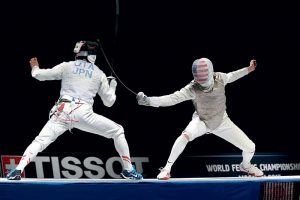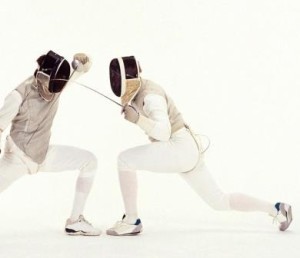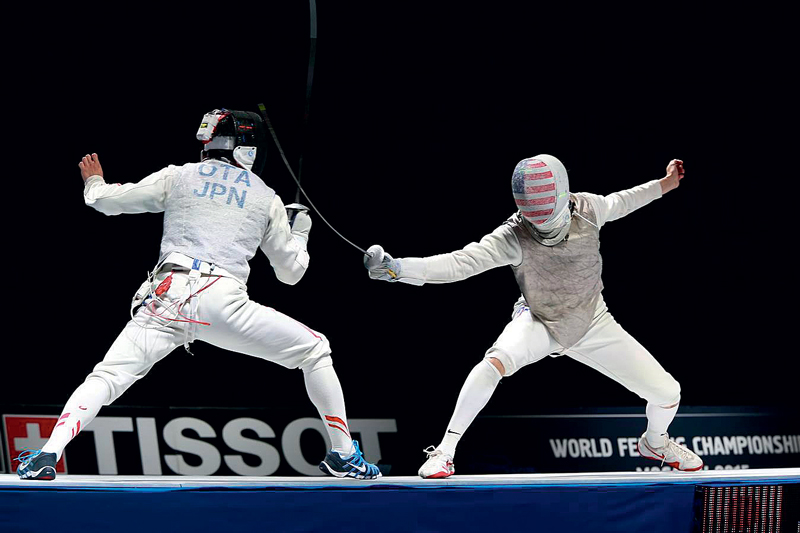About the principles of fencing
 Imagine someone seriously telling you that a tennis racket weighs 15 kg. And then another someone says that in football, the main force is whoever kicks the ball harder will win. Finally, the third one shares a terrible secret – the bicycle helmet is very fragile, so it does not protect the head, but put it on exclusively for better streamlining. Is funny And by the way, when it comes to wars of the past in general and fencing in particular, such pearls are heard regularly.
Imagine someone seriously telling you that a tennis racket weighs 15 kg. And then another someone says that in football, the main force is whoever kicks the ball harder will win. Finally, the third one shares a terrible secret – the bicycle helmet is very fragile, so it does not protect the head, but put it on exclusively for better streamlining. Is funny And by the way, when it comes to wars of the past in general and fencing in particular, such pearls are heard regularly.
This happens, in my opinion, from the fact that many people have little idea of what fencing is. If tennis, football and cycling are more or less familiar to us, then films and games are usually the main source of information about knives. Where everything looks completely different.
In this and a couple of subsequent articles I will try to explain in a simplified form what fencing looks like “from the inside”, what it is based on and why many myths are myths.
About the principles of fencing Fencing, Historical fencing, History, Dlinnopost, Hema
So, for a start, let’s take a look at an armless duel with a sharp-cutting weapon. It can be a duel of the royal musketeers, the Holmgang of the Vikings or even something from the Bronze Age – the basic principles will not change. And I will intentionally exclude everything related to psychology – we will assume that both fighters are experienced and cold-blooded.
What is important here? First of all, you can lose by skipping just one hit. Even if he was not fatal, pain shock + blood loss + dysfunction gives a significant debuff, which dramatically increases the complexity of the battle. As a result, the likelihood of missing another blow increases, which will cause even greater complications and so on. Therefore, the fencer is faced with the task of inflicting a wound on the enemy, not substituting himself. By the way, fencing is defined in this way: the art of striking without getting them.
Already at this stage, you can notice that the emerging picture is very different from what we sometimes see in games – when the fighters chop each other, gradually reducing the strip of health. But let’s go further.
About the principles of fencing Fencing, Historical fencing, History, Dlinnopost, Hema
Here are two fighters opposite each other. It would seem, come and hit, but harder – so for sure. Alas, here, as they say, there is a nuance.
The fact is that when one of the fighters starts an attack, the following can happen:
1) The enemy will have time to hit earlier
2) The enemy will take defense and strike back
3) The enemy, being wounded, will have time to inflict a more serious injury
I will explain a little the last two points. After a successful defense, the defender is in a favorable position, since the attacker is open and at a convenient distance. However, there are a lot of nuances that cannot be explained on the fingers … As for the latter, if a wounded soldier, for example, could launch an attack before being wounded, and no one canceled the inertia. However, there are also a lot of nuances.
It turns out that in order to conduct a successful attack, it is necessary:
1) Make sure that the enemy does not strike earlier.
2) Make sure that the enemy does not take defense, if he takes, at least he can’t answer, and if he answers, then at least defend himself from the answer.
3) Make sure that wounding the enemy you yourself will not miss a hit.
Complicated? And who said fencing is easy ?!
Therefore, if you watch fencing tournaments, you may find that fighters stomp for a long time opposite each other. No, they are not afraid. They choose the moment to attack. At this moment, the whole game takes place – by short movements, changing the position of the blade, provocations and false actions, optimal conditions are created for carrying out the attack. Then someone abruptly rushes forward … And usually that’s all. Either an attack, or a counterattack, or a repeated attack, in a word – some action is successful, the battle is stopped and the soldiers disperse.
About the principles of fencing Fencing, Historical fencing, History, Dlinnopost, Hema
How would it be in reality? Most likely, the attack was prepared even longer. After all, the stakes are higher, which means the risk is much less acceptable.
And what do we usually see in films? Long exchange of strokes, interrupted by cues and acrobatics. Such an exchange of blows is called a para-ripost and is used as an exercise, but no more.
Unfortunately, it is very difficult to describe in words how the preparation of the attack is built, but something can be understood. For example, that it should be fast. After all, the more time occurs from start to finish, the more time the enemy has to react. Therefore, deep swings, strikes in the jump and from the U-turn and other acrobatics in battle is of little use.
It turned out pretty long, but I do not know how shorter. I recently went to pikabu and don’t know how similar formats and just so narrow topics come in. I will be glad to feedback.
In the next article I will try to briefly consider fencing weapons and everything related to them.




